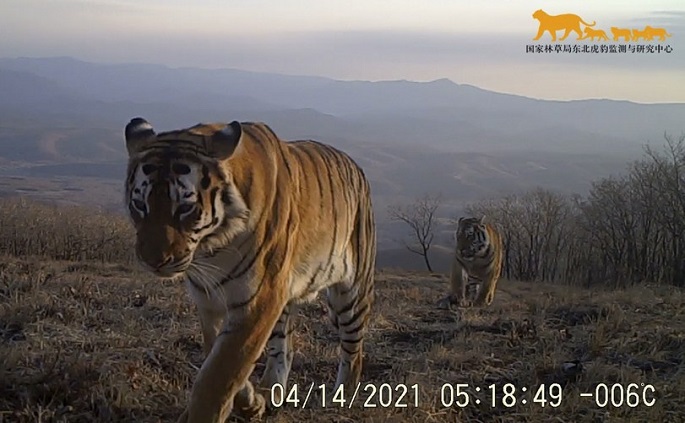Technology paves way for return of Siberian tigers to China
Published : 30 Jul 2023, 23:57
In an area spanning over 14,000 square km, it only takes a few seconds to trace a wild Siberian tiger, thanks to the more than 20,000 infrared cameras installed in the Northeast China Tiger and Leopard National Park, reported Xinhua.
Situated in northeast China's Jilin and Heilongjiang provinces, the park was on trial in 2017 and officially established in 2021. It is equipped with infrared cameras and an integrated intelligent monitoring system that covers the entire area to collect and record data on wildlife.
While strolling through the area, Zang Peng, a ranger with the Suiyang bureau branch of the park's administration, paused in front of a towering red pine. He then retrieved a green iron box from his backpack and secured it to the trunk.
"This is the infrared camera we use to trace wild animal activities. If a Siberian tiger passes by the camera, its infrared signal will turn the device on and start recording close-up videos," Zang said.
According to him, these cameras form the very basis for tracing and protecting Siberian tigers.
Also known as the Amur tiger, the Siberian tiger is one of the most endangered animals in the world and a flagship species of the forest ecosystem mainly living in Russia's Far East and northeast China. About 500 Siberian tigers are believed to be living in the wild.
In recent years, various technologies have been introduced to support the protection of Siberian tigers in the wildlife park, helping rebuild the kingdom of the mighty felid.
When Zang began his career as a ranger six years ago, one of the most crucial and exhausting tasks was clearing traps and hunting sets. The forest was filled with numerous hunting traps, as some locals used to rely on hunting wild animals for their livelihood.
Now, with the SMART system in place, which integrates various geographical information, trap clearing has become much easier for Zang and his colleagues. "Using the SMART system, we can upload and analyze the locations of animal tracks and hunting traps, and other information after patrolling, leaving no blind spots behind," Zang said.
As the park turns a much safer place for animals, the population of Siberian tigers increased continuously over the years.
As of this year's International Tiger Day, which is celebrated on July 29, there are about 60 wild Siberian tigers in China, rising from about 20 in the 1990s, according to the National Forestry and Grassland Administration.
In the jurisdiction of the park's Suiyang bureau branch, infrared cameras have captured images of wild Siberian tigers 415 times, with 10 adult individuals spotted.
In the park's Tianqiaoling area in Jilin Province, researchers were surprised to find a female Siberian tiger with four healthy cubs roaming in the forest.
However, along with the growing number of Siberian tigers also comes the increasing danger to patrolling rangers and local residents. With incremental activities of the wild predators, the park started to establish an early warning system to prevent human-tiger conflicts through the use of technology.
The early warning system is a part of the integrated intelligent monitoring system which collects real-time data on animal activities captured by infrared cameras, and also natural resources such as water, soil and air.
In the monitoring center, diagrams displaying Siberian tigers' activity frequency and active time are projected on the screen in a matter of seconds. The system can also recognize different wild animal species automatically, including the Siberian tiger.
Liang Zhuo, deputy director of the Siberian tiger protection department of the park's Suiyang bureau branch, said that through this system, they can send messages to local residents once tigers are spotted close to the village or farmland.
The intelligent system has resulted in reduced manual work and less human interference in the lives of wild Siberian tigers.
It has also helped build a Siberian tiger database, which can provide basic data for scientific research and protection work.
With the continuous integration of technological advancements into the development of the park, Siberian tigers are experiencing a peak in reproduction and undergoing rapid population growth. Experts believe that at least 50 percent of the tiger cubs can now survive to adulthood in the park.


